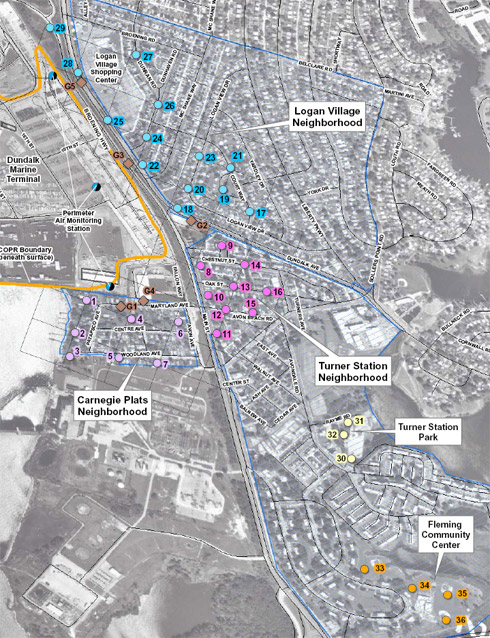Neighborhood Sampling Results
Neighborhood Soil and Groundwater Sampling
Results show there is no indication of COPR in any of the samples.
Honeywell is working with the Maryland Port Administration (MPA) to clean up Chromium Ore Processing Residue, or COPR, at the Dundalk Marine Terminal. The work is being supervised by the Maryland Department of the Environment (MDE).
Neighborhood Soil Sampling
In response to community requests, Honeywell voluntarily collected soil samples in July and August 2007 from 29 locations in Carnegie Plats, Turner Station and Logan Village to determine if there was COPR in any of the three neighborhoods. In November 2007, we collected three soil samples at Turner Station Park and four soil samples at the Fleming Community Center.
The soil from the samples tested is cleaner than the most stringent criteria established by MDE for hexavalent chromium.
Samples were analyzed by Lancaster Laboratories, an independent lab, using methods approved by the U.S. Environmental Protection Agency (EPA).
All of the sample results were significantly below MDE's residential standard for hexavalent chromium. This means that the tested soil is acceptable for residential or recreational use.
The map below indicates the locations where samples were taken.
Neighborhood Groundwater Sampling
There was no detection of hexavalent chromium in the groundwater samples.
Groundwater samples were collected from five locations. No hexavalent chromium was detected in the samples.
All results have been provided to the MDE, Baltimore County Department of Environmental Protection and Resource Management, MPA and the community.
Click on a soil sample point on the image below to view sampling results from that location. Move your mouse over a groundwater sample point for a summary of the collected data.


MDE Cleanup Standard for Hexavalent Chromium
MDE has established a residential soil cleanup standard for hexavalent chromium of 23 parts per million. Parts per million, or ppm, measures the quantity of a substance, in this case hexavalent chromium, in the total amount of the material that the substance is part of, in this case soil. One way of understanding what ppm means is the following example – one blue marble mixed in with one million green ones.
The MDE cleanup standard for hexavalent chromium in groundwater is 0.1 milligrams per liter. Milligrams per liter, or mg/l, is similar to parts per million but measures the amount of a substance present in water. The MDE standards are stricter than the EPA standards for hexavalent chromium.
Regulatory agencies use very conservative approaches in establishing soil and groundwater standards. The agencies look at the available human health and ecological information regarding a substance, and using extremely safe assumptions, set a standard to protect both humans and the environment.
For More Information
If any resident of Carnegie Plats, Turner Station or Logan Village has reason to believe that COPR may have been placed on his or her property, or if you have any questions about these results, please contact:
Sibyl Dinkins
410.869.2811
or
Connie Galiazzo DeJuliis
443.324.4624
